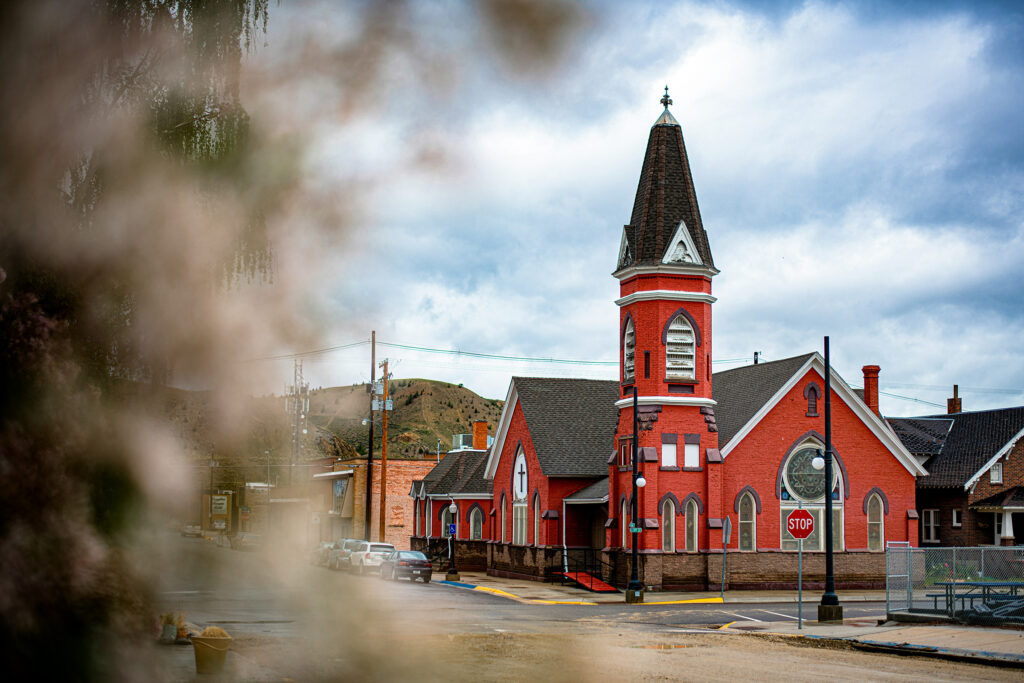Those familiar with Aaron Renn’s Three Worlds paradigm understand that, increasingly, Christians in the US find themselves in the “Negative World”—a setting in which to identify as a Christian is likely to decrease one’s social standing, given the strong prevailing winds of secular dominance.
This reality can easily cause us to merely seek our own survival. But what if, as some have recently suggested, we were to adopt an active, fortress-building strategy—effectively “reconquering” culture through Christian influence?
Whatever one makes of this aim, doubtless any project to reestablish Christian influence in our culture requires strategic and ambitious action, and there are many possible applications that would fit the bill. One specific, concrete, limited, yet significant action is the revitalization of Baptist churches.
Thousands of Baptist churches are declining and at risk of closing their doors for good. Many of these churches are located in Christianity’s historical stronghold in America: Appalachia and the South. Revitalizing these churches presents an opportunity to employ this sort of gospel-preaching, “cultural insurgency” mindset.
The late Navy veteran and evangelist Jim Wilson, in his Principles of War: A Handbook on Strategic Evangelism, describes the significance of the “decisive point.” In military strategy, the decisive point is a battle that is both feasible to win and worth winning. For example, making New York a Christian city would be strategic, but it’s not feasible right now. Likewise, as Wilson has often explained, taking some very small town in a state like Idaho might be very attainable, but not very strategic.
At first blush, it may seem like revitalizing small Baptist churches would fall into this latter category. But I believe dying Baptist churches as a category can qualify as a decisive point, being both feasible and strategic. The strategic significance of such a project can be seen in its potential for harnessing the principles of the insurgency mindset Renn identifies: owned space and shifting loyalties. Any one church may not meet the significance threshold to be a decisive point, but taken in aggregate and as part of a network of fortresses, the revitalization of Baptist churches is both feasible and strategic.
Owned Space
Many dying churches own their buildings outright. They may not have many people, but they have sanctuaries, education buildings, fellowship halls, and gymnasiums. New church plants often are forced to rent space from a school, theater, or other community organization, making them transient in the minds of the community and subject to the sensibilities of their landlords.
The church I pastor experienced several heydays in the 1960s, 80s, and 90s, but by the time I came in 2022, the attendance had dwindled to about 40 people on any given Sunday. Yet, thanks to the kindness of God and the faithfulness and fruitfulness of prior generations, the church owns remarkable facilities in the heart of a recently revitalized small town and has the type of financial resources that takes generations to build. In other words, our church isn’t going anywhere anytime soon. We aren’t going to be kicked out of our meeting space if my preaching runs afoul of the zeitgeist. Because of our owned space, we can weather some storms—and light a few fires of our own.
Of course, dying churches in need of revitalization are not unique among churches in having owned space. Healthy established churches often own their facilities, too. But the key is to form a network of antifragile fortresses with owned space. In our current situation, we need all the aligned fortresses we can get and can ill afford to lose these chess pieces off the board.
Further adding to the network effect, revitalizing churches often do not yet have enough people to fully utilize their owned facilities, which presents some unique opportunities to partner with other aligned institutions by providing them space to operate without fear of reprisal from landlords or the need to raise massive funds upfront. For example, these churches can use their space to house newly formed Christian schools, sports leagues, or even food co-ops or farmers markets. Any one of these might only represent a small fortress or outpost on their own, but together they begin to form formidable culture-building potential in a given locale.
Capturing Loyalties
Increasingly, there is a mission field to be had among normal citizens who are largely unengaged culturally and politically. Baptist churches are well-positioned to win the loyalty of such normal folks because they are, well, normal. The religious culture of America, for good or ill, is largely Baptist due to the proliferation of Baptist churches in the nineteenth and twentieth centuries. Many non-church-going cultural Christians in Appalachia and the South have personal and family roots in Baptist churches. Having grown up going to VBS and playing church basketball in Baptist churches as kids, the barrier to attending a Baptist church is low because they are familiar.
Further, the remaining members in these churches are latently aligned with many of the new, emerging Christian voices. They wouldn’t necessarily put it in those terms, but they realize the country they knew and grew up with is gone, and they can’t quite put their finger on how it happened or what to do about it. But they are eager for those who tell the truth without wavering and offer assertive leadership. When someone does that, their instincts align.
Therefore, if we can revitalize these churches and fill their pulpits with bold preaching that applies all the Bible to all of life, including making unapologetic specific application for today’s most pressing issues, we can capture the loyalty of normal citizens.
Further, while the dwindling membership of these churches might represent a short-term hurdle, the situation has a potential long-term upside because these churches have already experienced a pruning. By the law of averages, larger established churches will have more people among their ranks influenced by the prevailing secular cultural winds. These types of people often will have already self-selected out of the dying Baptist churches. The new pastor can then screen and filter new members by his preaching and public writing, attracting aligned members and repelling those who would subvert the mission from within. The long-term result is a stronger fortress.
We Can Do This
Revitalizing Baptist churches is feasible for at least five reasons. First, the Baptist understanding of the autonomy of each local church makes it easier for faithful pastors to enter the pastorate. This spares them the challenge of navigating denominational hierarchies that can easily fall prey to secular, progressive influence. Each church calls its own pastor, and due to a burgeoning national pastor shortage, many dying churches are simply looking for a few good men. An organization focused on connecting churches in need of revitalization with aligned and qualified men willing to pastor them could see tremendous fruit.
Second, revitalizing churches is feasible because people need shepherds. A pastor who loves and serves his people, who genuinely cares for their souls, who is present both in times of joy and seasons of suffering, who is a steadfast anchor in times of crisis, and is a faithful teacher of God’s Word will win the loyalty and following of his congregation. God made us to need and follow shepherds. Therefore, if we can connect true shepherds with true (if struggling) churches, God might be pleased to bless the church and turn it into one of the many fortresses that assume a forward position in advancing the kingdom of Christ.
Third, many of these churches are in Christianity’s historical strongholds in America—Appalachia and the South, still the regions of our nation most hospitable and receptive to the Christian faith. Fourth, and related, these regions are also home to many unbelieving, non-Christian conservatives and traditionalists who are ripe for the gospel that roots their desire to return to a better way of life in history, eternity, and truth. In other words, southern and Appalachian struggling churches who take a missionary posture toward cultural Christians and the cultural right have a bright future for revitalization.
Fifth, the proliferation of remote work makes revitalizing churches in rural and dying communities more viable. As more families seek to move out of urban and large suburban areas to more affordable housing and less intrusive government, the pool of congregants for these dying churches will grow. Likewise, many churches in need of revitalization can only employ bi-vocational pastors. In years past, the pool of potential pastors in these areas would be severely limited by the other job opportunities in the area. Now, with remote work, the pool of bi-vocational pastors available to a church is greatly enlarged.
Walking and Chewing Gum
One could be forgiven for seeing this call to church revitalization as being in opposition to international missions or church planting in large cities. But these ministries are not mutually exclusive. Churches in America can walk and chew gum at the same time. We can send missionaries to unreached peoples, plant churches in large American cities, and commit people and resources to revitalizing Baptist churches in our historical stronghold.
We can send missionaries to unreached peoples, plant churches in large American cities, and commit people and resources to revitalizing Baptist churches in our historical stronghold.
So, I am not advocating abandoning our international or urban focus but calling us to see the strategic importance of revitalizing churches. I’m calling us to cultivate the Baptist imagination, especially among ambitious young men who are eager to “attempt great things for God,” so as to see revitalizing Baptist churches in forgotten places as a worthy endeavor that can make a lasting impact for the cause of Christ in the West.
Mostly, I’m calling us to run where we are strong. If you were to make a heat map of the US highlighting belief in God and acceptance of Christian norms, Appalachia and the South would be deep red. Christianity is still woven into the cultural memory of these places, and the dying embers of once-healthy churches still dot the landscape. In other words, in Appalachia and the South, we find fertile soil and existing ecclesial infrastructure, a combination that makes these areas ripe for harvest.
The question then is one of means and will.
We have the means to devote significant resources and people to church revitalization. Southern Baptists alone, for example, give nearly a half a billion dollars every year to convention ministry and missions. And Appalachia and the South are home to millions of Christians and numerous healthy churches. We have the means.
Do we have the will? Are we willing to devote people and resources to the forgotten places? Are men willing to go pastor small congregations that will require serious persuasion to reach their communities with the gospel? Are believers willing to roll up their sleeves and do actual ministry rather than simply give money for someone else to do ministry in some far-off place?
I actually believe we do have the will, but that it is untapped. We rightly recognize the importance of evangelizing hard-to-reach foreign fields and church planting in inner cities, yet many Christians do not see the strategic value of bringing new life to struggling existing congregations. We have the men to get the job done, but they often lack vision, direction, and a plan.
Again, I’m not pitting church revitalization against international missions or urban church planting. My family spent seven years serving among unreached peoples in Central Asia. I believe in mission work. But I also believe we can regroup to restore a gospel influence leading to a Christian consensus in our own nation through revitalizing churches. And we can do both.
Another possible objection to this vision for church revitalization is that it’s just using the church for a political project. No! The primary reasons for revitalizing churches are love for God and love for people. We want healthy churches for God’s glory, for the good of the sheep in those churches, and to provide a faithful gospel witness in those communities. But actions can have more than one end. Just because re-evangelizing America is not the primary reason to do something doesn’t entail that it is not a good secondary reason to do something. The varied ends of church revitalization are integrated. We shouldn’t pit them against one another but rightly order them.
Make Christendom Great Again
There is a growing dissatisfaction with the status quo in America, and a growing coalition seeking the resurgence of Christ’s kingdom—some might call it a new “Christendom”—in the American context. What if we took some old-school Baptist energy with us into this new Christendom? And what if we propelled it? It’s fun to imagine deacons smoking on the back steps again, posting attendance in the front of the sanctuary, and making potluck Jello salad great again. But what we really need is men with chests who preach that heaven is real, hell is hot, the Bible is authoritative and sufficient for every area of life, the blood of Jesus cleanses from all sin, and baptism is for believers only. Further, they will preach the whole counsel of God’s Word, upholding that men are men and women are women, sodomy is a great sin, and Christ is the only answer for our cultural chaos. We need missions offerings, hymns about the cross, and neighborhood evangelism. We need thick communities who love the Lord and each other; who teach their children and the neighbor kids the Bible; who won’t give an inch to the forces that reject their faith and seek to destroy their way of life.
All of this is possible, and the soil is fertile throughout Appalachia and the South. Through these churches in these regions, we can preserve the best of our Christian past through turbulent times and join with other mission-minded believers to labor towards a gospel-saturated, Christian nation once again. This is both possible to do and worth doing. By God’s grace, and one church at a time, we’ll take our homeland again for King Jesus.
Editor’s Note: A version of this article was originally published on American Reformer. Used with permission.





